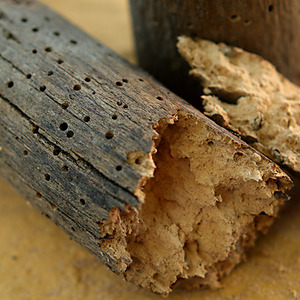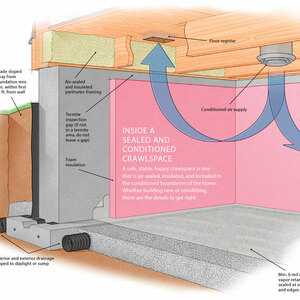I just received a set of plans for a finished basement. The architect spec metal framing. Now I come from the old school I prefer wood, I have done a few metal jobs and know how to use metal however I have a bias. I know there are advantages and disadvantages to metal and wood. Like metal studs are all uniform , unlike wood which can vary in size. However wood has better R values by 50% in some cases. Metal doesn’t rot and is impervious to insects and mold and doesn’t shrink.
This basement is 75% at grade and firm that designed it is out of NYC where they have to use metal for everything. This project is outside NYC where wood is acceptable and is mostly used in residential construction. The architect spec 2 1/2″ metal studs with 6 1/2″ of fiberglass insulation, now I know he has to maintain a certain R value to comply with the energy code, but stuffing 6″ of insulation in a 2 1/2″ space? maybe you could get the same R value with rigid insulation but it would take a lot more. I was always taught not to compress insulation in wall cavities. Normally I like to frame my wall with 2 x 4 wood 16″ oc with treated sills when the area allows myself the room with a 1″ air space, this allows more room for plumbers and electricians rather then just furring out the walls like some do. This basement is dry and does not have a water or moisture problem. My question is a 2 1/2″ metal framed wall 16″oc with 1/2″ rock how solid of a wall will that be? I have seen metal framed walls with a lot of bounce in them and that was with 3 5/8″ metal studs. Not to mention all my door jambs are 4 9/16″ in the rest of the house and Im going to end up with 3 1/2″ wall thicknesses. What do you guys think?
Edited 10/7/2005 4:39 pm ET by Phil


















Replies
We work with both wood and metal all the time. I did one basement remodel where we used metal just to see if there would be a savings. There wasn't. There was a decent amount of trim involved which required a bunch of wood blocking.
I would suggest calling the architect and talk it out with them. Tell them the house is framed with wood and you can give a better job for less money with wood studs 3 1/2" vs metal at 2 1/2". , yadayada. As far as the 6" insul, is that required by code ? You can't stuff bigger insul in a smaller cavity. And you definitely don't want the insulation touching the masonry foundation walls.
carpenter in transition
Dumb question, but why can't the insulation touch the masonry walls? Is it the material itself, or the fact that it's an exterior wall?Agree about stuffing 6" insulation in a 2 1/2" wall. And if those are partition walls, 2 1/2" is pretty slim. Sounds like someone without much experience.
I was always tought that insulation value is a function of air spaces in the insulation. R-12 becomes R-6 or worse, when compressed into a half-sized space.
Steel studs... your trim guy will hate you.
Just my opinion
locolobo, Edmonton, AB
If you compress standard density R12 FG insulation to half it's design thickness you'll get somewhat better than R6 -- maybe R7 or R8. Standard FG insulation is a long way from "optimal" density from an R per inch point of view.--------------
No electrons were harmed in the making of this post.
moisture.
any liquids on the masonry surface will saturate the fiberglass.
masonry foundations often leak.
therefore, always leave an airspace.
carpenter in transition
Timkline is right on the money--It only takes 3% moisture by weight in the FG to reduce the R value by half.Compress the FG and add some moisture and you might as well save yourself the itching and skip it--Mike" I reject your reality and substitute my own"
Adam Savage---Mythbusters
As you suspect they're probably specing metal because that's what's used in nyc and it's 2 1/2" instead of 3 5/8" because the 1" difference in width can add up to significant square footage in price/space crazy manhattan.
I would hope that they want you to frame the walls 8" or more from the basement walls to avoid compression, and moisture being wicked into the insulation.
2 1/2" metal stud with 1/2" rock can make a solid wall if done right. First be sure to screw both sides of the stud to the track, top and bottom. Second screw the rock to the track, not just the studs. Third use 20 gauge or heavier ( 25 gauge is so thin and flimsy it shouldn't even be an option IMO ). Lastly if there's room I'd use 3 5/8" studs for many reasons.
Hope this helps BUIC
Buic
They have 2 1/2" studs right up against the foundation walls. Now ive seen firms spec out a 2x6 exterior wall just to comply with the energy code. Like i said before i like to leave at least a 1" air space but that is with using the right size insulation with the right size framing material(Exp. 2x4 R-13, 2x6 R-19) that 1" space also helps you plumb up the wall when sections of the foundation are out of plumb. I really dont like have to challange these guys about how they think things should be built because they have the stamp and ultimate responsibility and they will start giving you all these real technical reasons for things. But we all know that are real world experiance in most cases makes more sense then the stuff these guys learned out of a book in the classroom. The problem is telling the homeowner that i dont agree with everything on the drawing.
I really dont like have to challange these guys about how they think things should be built because they have the stamp and ultimate responsibility
wow. wait until you do it their way and something goes wrong. let's see then who has the ultimate responsibility then. you, baby.
if your local code says that R-19 is required for insul, then 2 1/2" studs tight against the foundation with 6" fiberglass jammed into them is not R-19. you will find this out when the inspector does your insulation inspection and it will be your problem.
have these plans been submitted for the permit yet ?
don't hesitate to question an architect no matter where they are from. i'll bet there are a few other mistakes lurking in your drawings.
carpenter in transition
No they haven't been submitted yet. But I've done many jobs in this area and have a good relationship with the building dept
the reason i ask is because if your code dept. is good, they sometimes catch some of these issues, which helps take the pressure off of you.
carpenter in transition
No they haven't been submitted yet.
Its simple. You have a no go to build yet. Just ask the questions and get it straightened out. No biggie.
Be sure the HO gets asked the questions first. thats who youre working for and thats who will recommend you for future projects.
Let them deal with the archy, thats who theyre paying too.
If they want you to deal with the archy let them ask you to first..
Be a brownie point machine!
andyThe secret of Zen in two words is, "Not always so"!
When we meet, we say, Namaste'..it means..
I honor the place in you where the entire universe resides,
I honor the place in you of love, of light, of truth, of peace.
I honor the place within you where if you are in that place in you
and I am in that place in me, there is only one of us.
Phil - The framing tight to the wall could be an oversight on their part and they'll be glad you caught it... hey you never know!!! Honestly I'd still bring it up to the arch. in a way that won't offend. If that goes nowhere then I'd speak to the homeowner about your very real reservations. If the insulation gets damp and the rock begins to grow mold, it'll be you, not the arch. that will be the first one called.
On something others have brought up, shooting trim to metal isn't a big deal, I do it on a weekly basis. Any 15 gauge nail will go into a 20 gauge stud reliably. A 2x lining a door opening is always a good idea to help hang the door securely.
I've worked with metal framing for 20 years, if I can be of any other help, just ask... BUIC
Thanks for the offer Buic, i talked to the homeowner and brought up my concerns she seems to agree with me and is going to talk with the arch i will let you know how it goes.
Thanks
You may want to talk w/ the architect about gluing XPS foam panels on the walls first and then snugging the 2 1/2" steel up to the foam. This will solve many of your moisture issues and eliminate thermal bridging between the steel and the walls. Some also recommend putting 1/2" foam or sillseal under the bottom steel track for the same reasons. Thermal bridging from the foundation to steel can cause ghosting on the finished wall. You can always put fiberglass insulation in the wall cavities
See http://www.buildingscience.com
Also see page 32 (printed page 26) about basements:
http://www.buildingscience.com/resources/mold/Read_This_Before_You_Design_Build_or_Renovate.pdf
Billy
Edited 10/8/2005 9:54 am ET by Billy